
Khadi woven in Ponduru, a small village 30 kilometers from Srikakulam city, acquired fame in the pre- independence era when Mahatma Gandhi mentioned its virtues in Young India, the national weekly that Gandhiji edited.
One of the finest, Ponduru khadi is soft to the touch and comfortable on the skin. Sold as yardage fabric, sarees, dhotis, towels, shirts and more, Ponduru khadi is widely in demand in various countries across the globe and especially chosen by people of India and in particular by senior citizens and People Representatives, for its high quality and sheer simplicity. The Ponduru Khadi was worn by eminent personalities like Mahatma Gandhi, Indira Gandhi, Akkineni Nageshwar Rao etc who were impressed by its shine.
These popular Dhoties are traditionally woven using the interlock-weft technique and have mostly small and big borders of Tussar Silk Pattu. The Dhoties and U ppers are either in grey / PT colour or in pure white.

Produced locally from Punasa cotton, the weaving process is painstakingly meticulous requiring immense dexterity. The process begins with cleaning the cotton with a comb – made from the jaw bone of the “Valuga “ (cat) fish bone– to lend it a silky sheen. The straightened fibers are pressed and rolled on a wooden plank with a metal rod and each deft stroke casts away seeds from the cotton. The separated fibers are then rolled in to strands on wooden cylindrical sticks and spun on a charkha to yield yarn that is finally dyed using natural dyes.
A differentiating feature that sets the Ponduru Khadi a class apart from other woven materials is the simple fact that it is completely hand spun to ensure that its softness remains intact.

The Narayanapuram village lies on the south eastern coast of India,known for the traditional Bobbili Cotton Saris. If you wander in the pathways of this village, you will find many family homes with brightly colored threads in multi-colored hues shining on their verandas, and it is in these family homes where the vibrant Bobbili sari is given life
These sarees are Dark and Medium coloured, light weight of (6/7) yards. Woven in fine count of yarn, are known for their softness and low cost.
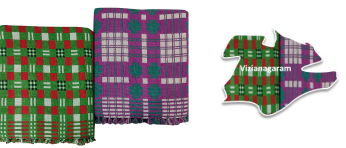
The Weavers of these Rajam and Boddam areas produce coarse variety of Design & Double cloth bedsheets and towels on multi treadle frame looms, made of premium cotton which makes it very soft and ensures comfort. The design of these products come in a geometrical square, rectangular pattern which is predominant in the region of Andhra Pradesh.
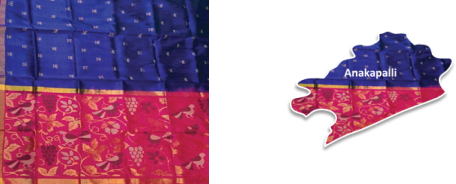
The history of Payakaraopet dates back to the 6th Century BC. In fact, the town was a part of the Kalinga Kingdom and was later conquered by the Emperor Ashoka. The town has a place in the Hindu and Buddhist texts and Buddist remnants found to this day are testimony to its past glory.
The Weavers from this noteworthy town create striking Payakaraopeta Silk Sarees and Dress materials that stand out for their stunning designs and beauty.
In the recent times, Payakaraopet Weavers have upgraded their skills and have included Jamdhani technique of weaving to enhance the quality of Silk Sarees. Despite its intricate weaving patterns, the weight of the Saree is around 600 grams.
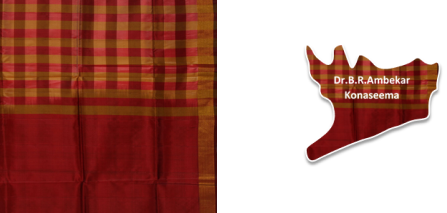
Bandarulanka sarees, woven in a small village that goes by the same name in “Konaseema” District, are renowned for their earthy hues and 80’s count fine combed cotton yarn.
The sarees are defined by Dobby, Pattu borders and Zari /Cottonbutas. Contrast Colours are often used for the saree pallu and the body for a contemporary look, albeit weavers are also partial to the traditional mono tone sarees. Many a time, the pallu is adorned with elaborate designs for a fancy look.
80s X 80s Cotton yarn are used for both Warp and Weft. Width 45” and length 5.40 Mts.
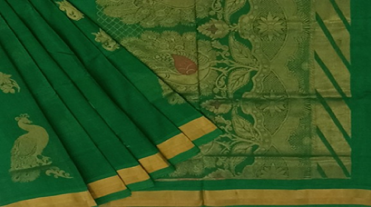
Among the many weaves, handlooms, and weaving communities in Konaseema district, the village of Angara holds a special place. Resplendent in the many kinds of cotton and silks that are woven here, one is awed by the colours, designs, and finish of the fabrics at Angara.
A little village in the winding lanes of the scenic Konaseema district, Angara is where one finds an array of colourful Jacquards, butta sarees, all kinds of cotton, and silks. Painstakingly created on a handloom, the weaving community here takes pride in the work it does, as it works towards bringing new designs to the loom. They constantly keep a tab on the market and try to create something novel. They have thus been able to produce fine kinds of cotton, classy slab yarn sarees and much more, some of which became time-tested classics.
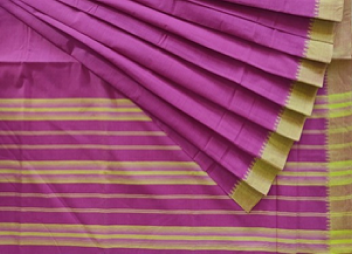
Pasalapudi, a small village in Kona Seema district of Andhra Pradesh produces beautiful plain cotton sarees. The contrast plain borders with saw (Rampam) borders is the speciality of Pasalapudi sarees. 80s and 60s fine combed cotton yarns are used in the production of these elegant plain sarees without any extra weft ornamentation. These simple sarees with pastel to medium colours make it suitable to be used by women of all age groups.

The Uppada Jamdani silk saree dates back to the 18th century when Jamdani, a Persian word, denoting an art of weaving that originated in Bengal, was revived and introduced to weavers in the twin coastal villages of Uppada-Kothapalli in the Kakinada district of Andhra Pradesh.

The saree, also coined as Andhra Uppada is inspired by the Jamdani tradition but maintains a distinct local character resulting in acquisition of a GI tag in 2009, with paisley, floral and geometric motifs woven on the finest of pure silk.
Cotton is used for both Warp and Weft and Zari for Extra Warp & Extra Weft. Threads are interlaced to form the designs and no wonder, the magnificence of the saree shines through every thread.
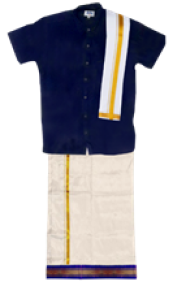
The weavers of Peddapuram village are famous for the traditional Indian Men’s Wear, the Dhoti which is also popularly known as Veshti, Mundu, Panche. The pure Silk Dhoti lined with Dobby zari with Ganga-Jamuna (red and green) border is woven on a Handloom using Mulberry Silk Yarn.

This is pure Silk Plain Shirting woven by the weavers of Peddapuram village on Handloom using Mulberry Silk Yarn. The weight of the cloth is around 55-60 grams per sq. meter. Besides, beautiful silk sarees are woven in this region.
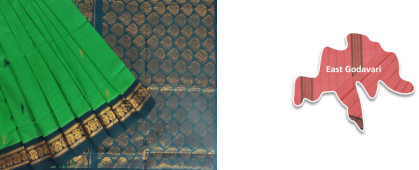
Pulagurtha village is located in Anaparthy mandal of East Godavari district and houses a fine variety of Pulugurta Malka Shirting that is made of cotton yarn spun on a micro spinning machine. About 10kgs of yarn can be produced on this spinning machine per day.
Malkha fabrics are woven by skilled weaver families on handlooms from cotton grown in smallholder farmer families. The Malkha process puts the intermediate stage of cotton spinning back in the village, making the entire textile chain from cotton to cloth village-based. They handle the delicate cotton fibres gently, avoiding the force and violence of conventional processing, keeping the springness of the live fibres all the way into the cloth. That's what gives malkha fabric its swing and drape. Malkha is energy efficient, avoids bailing and unbailing of cotton by heavy machinery and unnecessary transport. Malkha fabric is soft, it breathes, absorbs, holds colour, reflects its handmade heritage in texture.
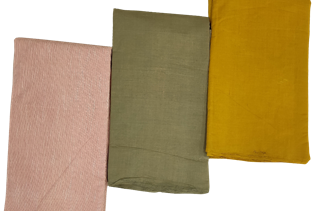
Pulagurtha Sarees are famous for good texture that come in medium to dark colours. Pulagurtha sarees are woven by using the Jaquard technique of weaving. This region is well-known for its designs and interventions in handloom products and sustainable handlooms.
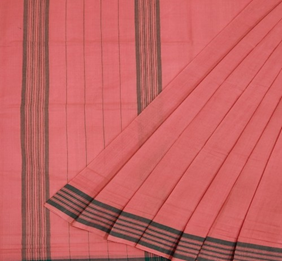
Fine Cotton yarn of count 100s (2ply) is used in production of Muramunda Cotton Shirting that comes out in plain, Stripes and Check patterns. Besides, a fine variety of sarees are woven by using 80s and 100s count of yarns with good texture and bright colours. The sarees are woven mostly in plain without any extra ornamentation to the fabric. This minimalist product derives its charm through its colours and a simplistic design, and favoured by most of the women in this region.
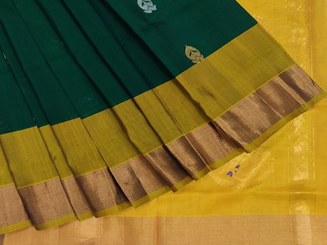
Veeravaram is located in Kadiam Mandal of East Godavari district and famous for Handloom Sareers. The weavers of Veeravaram have upgraded their skills from weaving of coarse variety of fabrics to fine quality of sarees by using silk yarns. The significant feature of Veeravaram sarees is its simple borders and rich pallus which gives an elegant yet classic look when worn. These sarees are widely worn during marriages and festive occasions in this region.
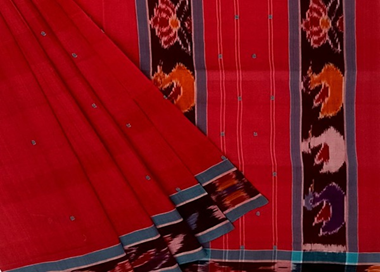
Dulla is a Village located in Kadiam Mandal, East Godavari district. In Dulla area, fine quality of sarees are produced by using 80s cotton yarn with bright colours specially Tie & Dye motifs in the pallu as well as woven butta in the body by using dobby loom. The designs on the borders and pallus define their epitome of beauty.
Altogether, the region of East Godavari cannot be restricted to being specialized in one handloom design/product, but promises to innovate in all aspects of a handloom process along with preserving its rich heritage in weaving.
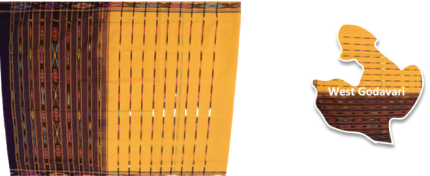
Light weight sarees in low texture are produced in this area by using 80s cotton yarn for both Warp and Weft. These sarees are widely used during summers. They keep you light and comfortable throughout the day. Cotton is innately hypoallergenic, so you get no complaints of rashes and itching due to heat. The designs of the saree gives a touch of elegance and ethnicity to it.
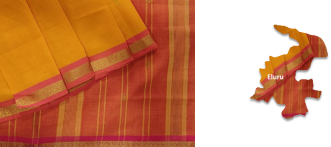
Light weight cotton sarees are woven in Eluru of Eluru District, by using 80s & 60s count combed Cotton yarn. The variety includes plain sarees, complimenting the finely textured body with richly attractive characteristic petu borders which gives an overall aesthetic appeal to the saree. Colours vary from medium shades to dark shades.
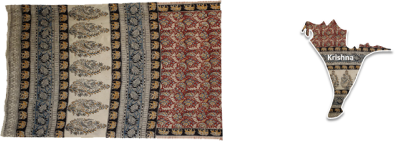
Machilipatnam’s Kalamkari art of printing on fabrics is an art which has a worldwide recognition. Kalamkari is known to be a healing fabric, as the colors, motifs and the narration of magical forms create an aura that heals an individual physically and spiritually. This technique involves dye-painting on fabrics with a block using eco-friendly natural vegetable colors.
This art style evolved during the Mughal rule and flourished under the Golconda Sultanate. It is rendered on to a wide variety of textile products such as wall hangings, clothing bed sheets, curtains, sarees etc. The speciality of the Kalamkari painted fabric is that the finished products are mellow , bright colours are used but the finish is very subtle . The fabric looks better and better with every wash , with designs standing out even better against the background.
The production of Machilipatnam Kalamkari is geographically limited to Pedana town, Krishna district of Andhra Pradesh. While Pedana and Machilipatnam are the hubs for hand block- printed Kalamkari, Srikalahasti in Chittoor district of Andhra Pradesh is known for the pen- drawn format.

Bandar/Polavaram sarees are Woven in and around Machilipatnam in Krishna District. Densely Woven in 80s count with super fine combed Cotton yarn, these sarees are woven mostly with Petu borders and Cotton butas.
Colours vary from pastel shades to dark shades to appeal to both urban and rural women. This variety of sarees is preferred as daily attire by women of all age groups.
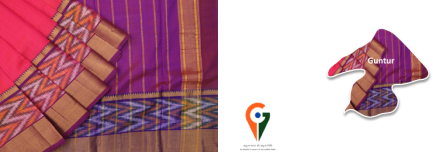
Mangalagiri sarees are recognized by their famous but elegant Nizam borders. These silk-cotton sarees come with a rich look, offered at low prices which embody vibrant expressions of beauty and are woven in different warp and weft colours, so that when light falls on them, they shimmer with a magical, double-tone hue.
With micro checks or stripes between the Nizam borders, the fabric of traditional sarees flow into pallu, often a quiet mono- striped affair adorned with zari in a typical tribal style. Moving with the times, today, the soft and airy fabrics of Mangalagiri are redefining the world of ethnic fashion, growing beyond sarees to include tunics, blouses, scarves, stoles and even Sling bags.
Mangalagiri sarees are woven in pit looms with finer counts of 80s Cotton yarn. The process begins with removing impurities from the yarn, dyeing, drying and spinning on traditional charkhas. Cotton strands are reeled into spools and then loaded into spindles to be inserted into the fly-shuttle for processing the weft. During the process of warping, the yarn is checked for tangles, breaks are knotted and the thread is sprayed with starch at least 10-12 times to lend strength, durability and sheen to the fabric.

The weavers of this area produces coarse variety of Bedsheets on multi treadle frame looms. The colours of Satennapalli bedsheets are mostly brightand have checkered or plaid pattern. The bedsheets have ahigh local demand now the product is being diversified into cushion covers, bolster covers etc.
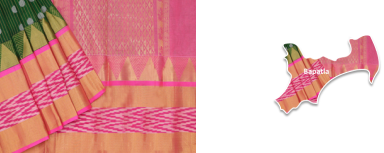
The sea sidetown of Chirala- from cheera meaning saree and la meaning possession – is famous all over the world for its sarees and handlooms. As a centuries-old occupation of the Padmasali, Devanga and Pattusali communities, Chirala silk sarees are soft and feather light that they even inspired the Italian explorer Mark Polo to sing paeans on the skill of weavers who could weave a saree that could be folded in to a match box.
Classic and legendary among india’s handloom textile traditions, Chirala Sarees are favoured the most for its intricate hand buta, a fascinating design feature in which colours are added manually in the Zari design and also applies Kuppadam, a weaving technique that create solid borders.
The Yarn is first washed and dipped skilfully in the colour of choice to give the fabric a unique and durable hue. After a second wash and starch application for permanent colour and lustre, the yarn is turned in a charka to get the thread for the weft.
The loading of yarn in warp is done in pit looms that are fixed at the ground level. One pacham is then loaded and weaving begins with the weaver sitting on the floor and weaving by using his hands and legs.
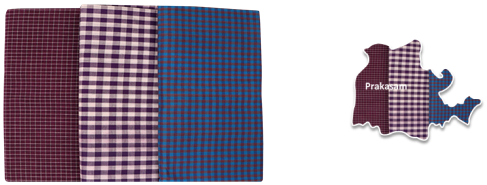
The Weavers of this area, particularly Eathamukkala, are famous for production of 60s X 60s Combed yarn Check Lungies. It is easy to wear and very comfortable as it is hand woven. These lungies are comfortable to use both in summer and winter conditions, and colour is durable. These lungis are light weight and shrink resistant which is why it is a most preferred choice of men in Andhra Pradesh.
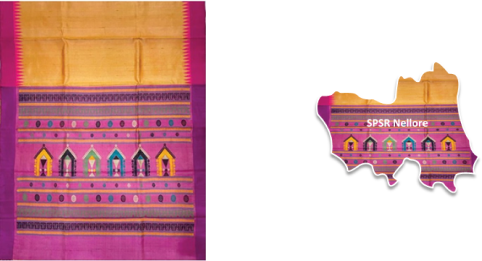
The speciality of the sarees made in Paturu is that silk is used in warp and cotton in weft to give a grand look and at make it more affordable and comfortable for the women. Here, every household turns beautiful saris in the attached workshed labouring for hours together at a stretch.
These sarees are usually eponymous of the region they come from. Cotton, Silk, and Zari (gold thread) threads are hand-woven together to craft these beautiful cotton silk sarees from village of Paturu.

In ancient times chitrakatts or storytellers — a travelling band of artistes— would often travel from one place to another, recounting stories of Hindu mythology to the people. In order to illustrate their accounts and render a visual appeal, they would take large bolts of canvas and with colour extracted from nearby trees and plants, they would depict the tales through drawing and painting. This practice not only helped them to connect with people, but also reached temples and gained eminence as a form of art.
Srikalahasti Kalamkari depicts stories of great moral value drawn from the mythological Puranas, the Ramayana, and the Mahabharata.
The Srikalahasti style of Kalamkari is one of the two styles of Kalamkari works present in India, with the other being, Machilipatnam style. Kalam in persian language means Pen is used for hand drawing and coloring. Using rudimentary tools such as burnt tamarind sticks, specially-crafted bamboo sticks and organic colours, kalamkars create spectacular designson fabric bolts, sarees, bedspreads, curtains and more. The sarees are most notable for their borders and pallu.
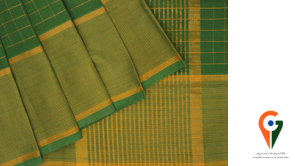
Venkatagiri sarees, softest and most durable, reflect the ingenuity of weavers and are woven in Venkatagiri, a small town in Tirupati district. Soft in texture, with solid- colour bodies, ribbon like zari borders and tiny motifs of fruits, birds, leaves and more sprinkled all over, these sarees are as regal as ever and continue to be famous across the world. The jamdani technique is used for weaving motifs in a venkatagiri sarees and is more intricate than the uppada jamdani saree. The Venkatgiri saree is also considered to be a traditional ritualistic handloom product as it depicts the stories of Ramayana and Mahabharata .
In the early 1700s, sarees, turbans, angavastrams and dhotis were woven from fine muslin — exclusively for the royals of the Velugoti dynasty, Bobbili and Pithapuram dynasties and the zamindars of Nellore. The sarees, usually white with zari borders or coloured bands, were mostly woven for queens and noble women and soon became synonymous with an aristocratic appearance.
Previously Venkatagiri sarees were made with fine cottons of 100s, 120s counts and had simple borders of gold thread and richly brocaded pallus. But in the recent times, weavers began experimenting with fabrics and patterns and now weave sarees in cotton- silk and pure silk as well. Nowadays, Venkatagiri Paithani sarees are also being woven in this region.
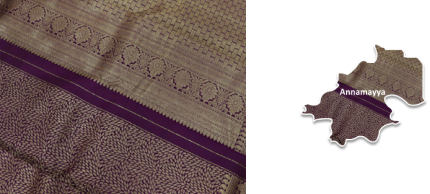
Madanapalle, earlier known as Maryada Raamanna Pattanam, is also known for silk sarees. There are weavers whose sole livelihood is weaving of silk sarees, and the sarees they weave are known as Madanapalle silk sarees. The silk sarees are known for their endearing charm of silk, high quality where grace meets comfort, and sarees that accentuate the beauty of the wearer. The town is famous for silk and silk products, and quality of silk is remarkable. Madanapalle silk sarees are sought after by women as an ideal pick for weddings and sacred occasions.
The sarees come with matching blouse pieces. A Madanapalle saree could be in a divine mustard colour adorned with motifs and woven in zari and resham (silk) with a distinct pallu embellished either in floral or paisley motifs or both. The colours of the sarees range from terracotta to ravishing grey, or pastel to radiant blue or violet and styled with contrast pallu with stripes, and motifs of temples to nature, and borders with zari. For the current generation, the sarees are woven in dual colours and reversible printed varieties.
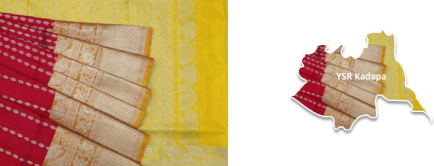
In 1003, Madhavaram catapulted to fame when the story of the Ramayana woven using 15 tolas of silver and three tolas of gold threads on a saree reached the royal courts of Mysore, Pithapuram and Venkatagiri. But, it is the Ramayana saree that exemplified the skill of weavers of this tiny village nestled between the River Penna and the hills of Kadapa.
At present Madhavaram is 20 Km. away from the district Head Quarters, Kadapa. This village is rehabilitated under Somasila irrigation project and was re-built on the highway of Kadapa to Chennai.
Woven by the Togata, Padmashali community, Madhavaram sarees in cotton, silk- cotton and silk come in a variety of designs - from floral to geometric. With petu borders and jacquard or zari pallus, the sarees are soft, vibrant and classy and favoured by women both as regular and special occasion wear.
Today, silk weaving has taken a backseat but Madhavaram’s 80 to 120-count sarees continue to enjoy fame and favour including the Madhavaram madhuparkams worn by Telugu brides and grooms during wedding rituals.
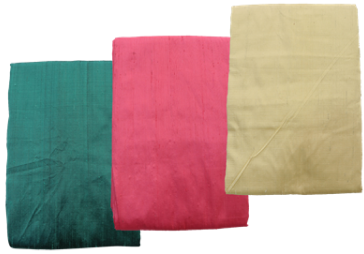
Raw Silk Shirting locally called as Dupion Silk Shirting is also used as furnishing material. These shirting styles are widely used in parts of Rayalaseema, consistently developing a significance of style among men in these regions. Bright and attractive colours shades are produced in 45” and 54” width, with the product spreading its influence to Karnataka to an extent that most of the material is purchased by traders in Bangalore. They export the material to other countries and also sell in the Domestic Market.

This town Yemmiganur is since ancient times known for handloom weaving catering to domestic as well export market, with chief trade being weaving. They produce a variety of products including sarees. However, Yemmiganur is famous and one - stop place for Bedsheets, Towels and Carpets. These handwoven bedsheets, towels have the ability to regulate body temperature. In summer, these bedsheets can help you cool by wicking away sweat and allowing air to circulate.

Gadwal Traditional Sarees produced in Kodumuru, are notable for solid Colours woven on both sides of a Saree. The raw material used in the production of Gadwal Sarees is silk and cotton along with zari. A fine cotton yarn is used in the body of the Saree and the border & pallu are woven with filature silk.
The silver zari threads are used for the ornamentation in the border, pallu and in the body (for butas). Three shuttles are used to weave the saree, one at the borders and another for the body to get the solid border effect (kuttu) with the assistance of a helper. For every saree, the portion is pieced with silk Warp specially made for Pallu, by cutting the cotton threads/Warp.
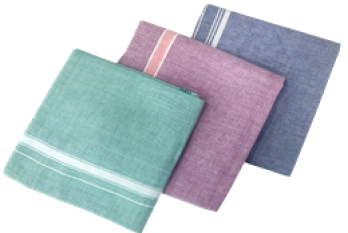
Nandivargam area in Nandyal district is famous for weaving of coarse variety of plain towels and lungies in both white and chengai colours.
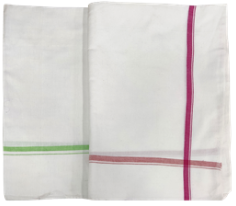
These plain towels and lungies are made of cotton which makes it very comfortable on the body and is highly heat absorbent. These characteristics makes it perfect for the climate conditions of this region.
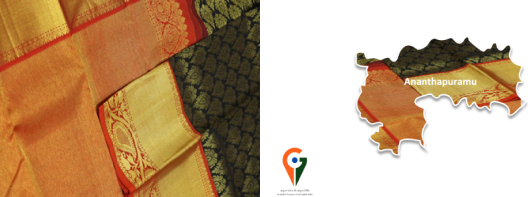
Dharmavaram sarees are the exclusive patronage of the town of Dharmavaram, in the Anantapur district of Andhra Pradesh. By the 19th century, the mulberry silk Dharmavaram sarees found nationwide recognition for the sheer brilliance and beauty of the weave. Woven initially as wedding sarees, in shades of red and yellow, the weavers innovated over time to include all colours, motifs, designs and embellishments to keep up with the changing times and increase their client base. The Weavers of Tadipatri, Yadiki, Uravakonda, Rayadurgam, Pedapappuru etc., located in Anantapur District produce Dharmavaram type fancy silk sarees.
Dharmavaram sarees are one of the most religiously and ceremonially accepted sarees. Hence, most of the motifs are oriented towards such emotions. Peacock feathers and peacock motifs make for the most popular designs. The inspiration has been drawn from temple architecture and such motifs are routinely represented on saree pallus. These sarees have a distinct gold plated border with self-printed art work. Motifs also depend on the discretion of the weavers and their genius.
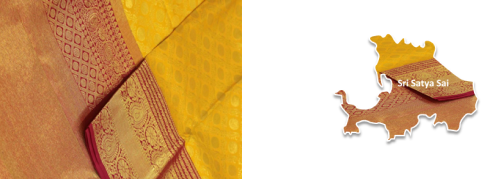
Dharmavaram a small ancient town in Sri Satyasai district, is the seat to Dharmavaram Pattu Saree and the Paavada from the 19th century onwards. The splendid Dharmavaram Pattu is the sum total of many factors
: lustrous dual – colour, broad borders and pallus in solid colours, intricate motifs and lavish zari.
Worn mostly during weddings and religious ceremonies to symbolize richness and sanctity, Dharamavaram sarees were earlier available only in shades of yellow and maroon. Today, however, weavers experiment with diverse colours and even add rich embellishments such as coloured stones, sequins and kundan for a more contemporary look.
Woven with mulberry silk and zari by interlocked weft method, the process of making a Dharmavaram saree usually takes 4 to 8 days. It actually begins with boiling silk yarn, soap and caustic soda and then leaving it to soak overnight in the same liquid. Once the yarn is taken out, it is dyed in the chosen colour and washed again in the solution of water and acetic acid to lend the beautiful sheen that these sarees are known for.
The dyed yarn is then dried indoors on bamboo sticks before the warp is prepared and thread roles are mounted on the dolu which is then provided to the weaver to use it for the warp of loom frame. The weaver then readies the loom which is controlled by punch cards, each row of which corresponds with one row of design. The warp yarn is then loaded by attaching each strand to the loom.
Jacquard weaving is also popular wherein designs are loaded on the computer, punched in a card and then loaded on the Jacquard loom.